|
Before we explain test procedures, we will describe the operation of a solenoid to help you to better understand how a water fill valve works.
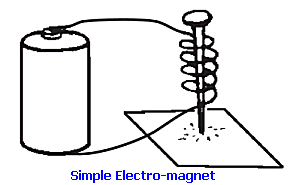
A solenoid is simply an electromagnet. You may remember from your younger days building an electromagnet using a nail, a coil of wire and a battery as illustrated above. This is the basic working principles behind a solenoid but instead of picking up metal filings, the magnetism generated is used to move an armature which can do work.
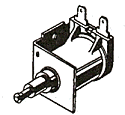 In most appliance solenoids, instead of having a stationary pin (nail in the illustration above) around which the coil of wire is wrapped, the coil is wrapped around a hollow tube. Through the center of this tube a metal armature is installed which is affected by the magnet field produced whenever power is supplied to the coil. This armature can be attached to levers to lock or open a door for example and powered via an electrical switch when needed to activate it. In most appliance solenoids, instead of having a stationary pin (nail in the illustration above) around which the coil of wire is wrapped, the coil is wrapped around a hollow tube. Through the center of this tube a metal armature is installed which is affected by the magnet field produced whenever power is supplied to the coil. This armature can be attached to levers to lock or open a door for example and powered via an electrical switch when needed to activate it.
In a water fill valve, the solenoid's actuator is attached to a diaphragm which opens or closes a route through which water can pass. When not engaged the diaphragm is closed and no water should flow. As soon as the water valve's solenoid coil is powered, the armature allows the diaphragm to flex opening the passage and allowing water to flow.
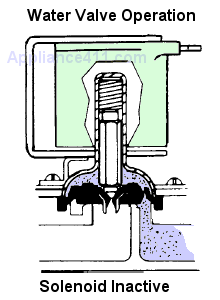
Appliance fill valves can be single solenoid type (like used on most dishwashers or icemakers), double or dual solenoid like used on conventional cloth washers and refrigerators equipped with both an icemaker and water dispenser or have even more solenoid coils. These multiple solenoid applications will have two or more separate solenoid coils each with separate wire leads attached to them.
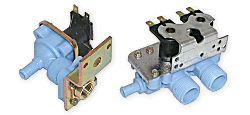
Being that these solenoids are just a single coil of wire, they can be tested for continuity to see if open or not.  The exact resistance doesn't usually matter as long as it has some resistance (ie. shows continuity). The symbols to the right shows how such a component may appear on an electrical schematic or wiring diagram. The exact resistance doesn't usually matter as long as it has some resistance (ie. shows continuity). The symbols to the right shows how such a component may appear on an electrical schematic or wiring diagram.
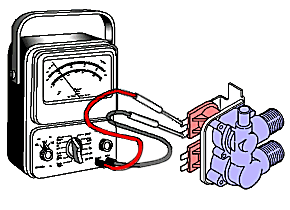
While the water valve's solenoid coil would be defective if it were open, just being closed doesn't necessarily mean the water valve is good. The solenoid's internal armature could be seized in place and unable to move at all or the diaphragm may be defective inside the valve and be unable to stop the flow of water.
On solenoids which use regular house voltage (120 volts), connecting power directly to the coil can sometimes be use to determine if all inner parts of the valve are functioning properly or not. When directly connected to a power supply, a water fill valve should open and allow water to flow through it.
There are some cases where this too is not enough to determine proper operation. The wire inside these coils can have a break which sometimes only opens fully when under strain or when energized for a extended periods of time. This can create inconsistent testing results.
Under these conditions the coil can heat causing the internal coil wiring to expand temporarily. This expansion widens any break, opening the circuit but may close again once cooled or disconnected from power. This seems to happen more often on dishwasher water fill valves or dryer gas valves but can also occur on other solenoid applications as well. In the case of a water valve, the above 'direct connect' test may be required for extended periods (several minutes) to absolutely determine the solenoid coil's proper functioning.
| 

